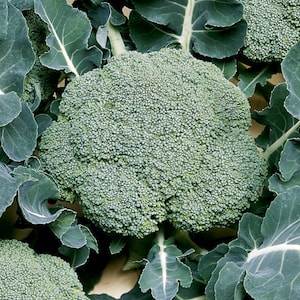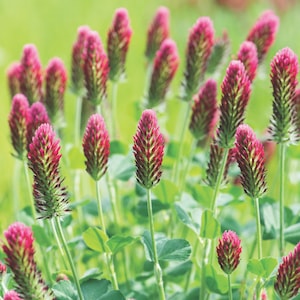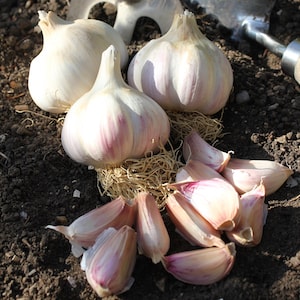What to do in your allotment in August
Written by Lee Senior
Last month’s rain and sunshine made for quite a good growing spurt, yielding plenty of tasty crops. I’m particularly happy with my superb crop of purple ‘Celine’ French beans. I like to steam them (like most of my veg) so they retain their vibrant colour and fine flavour.
My runner beans have started cropping too, and the tomatoes are suddenly ripening overnight! And if that isn’t enough, it’s show season… We’re at the peak of summer on our allotments and it feels great!
I usually start to notice the days beginning to shorten from mid-August. On the plus side, there’s a bountiful harvest to enjoy with a vast range of crops coming into season. If you plan to grow them, now’s the perfect time to buy autumn-planting garlic and winter onion sets ready to plant out from late September. Happy growing!
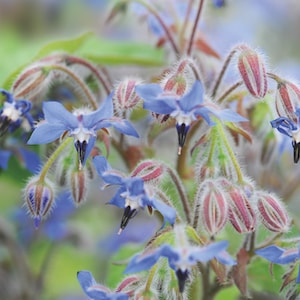
Image: Herb Seeds – Borage
Allotment flowers in August
- Sow F1 Pansy ‘Frizzle Sizzle Raspberry’ now for flowering over the milder periods of winter.
- Sweet peas are at their peak now. Pick regularly during August and remove any spent flowers and seed pods to discard.
- Continue to deadhead all of your flowering plants this month to keep everything tidy and prolong the flowering season.
- Gladioli flowers are at their best from mid-July through to August. They’re great for allotments and make very good cut flowers.
- Perennial echinacea (coneflower) is an attractive stalwart of the late summer border. The plants are low-maintenance, easy to grow and don’t need staking. Great for allotments, the flowers attract pollinators, can be cut for vases and even have medicinal uses.
- Sweet Williams (Dianthus barbatus) are a fine cut flower if you have a spare patch of soil. Get young plants in the ground this month so they can establish themselves before the onset of winter. They’ll flower from next spring.
- Hydrangeas are currently strutting their stuff, with large mophead-sized blooms out in force. The white-flowering varieties ‘Candlelight’ and ‘Annabelle’ add a welcome bit of sparkle to semi-shady areas.
- Pick borage flowers to add to cooling summer drinks and salads. If you haven’t grown this versatile herb this year, make a note for next year. Its edible flowers are also insect magnets!
Allotment vegetables in August
- Plant your winter vegetables out onto the plot if you haven’t already.
- Transplant any late-sown crowded young swede and turnip plants into their final positions as soon as possible. Keep them well watered for the next few weeks as they establish themselves. If the weather is good, they should provide a worthwhile crop during late autumn and early winter.
- Sow spring cabbage seeds directly into an allotment bed or move spring cabbage plants into their final positions. Cover with cabbage butterfly proof netting. They’ll be ready to eat next spring.
- When your peas or beans have finished, clear the beds and follow with brassicas. Brassicas are hungry feeders and will benefit from the nitrogen boost that legumes leave in the soil. Keep all brassicas covered with fine netting to protect from cabbage white butterfly.
- Direct sow pak choi seeds in early August for quick crops of crunchy leaves. If you like stir fry veg, why not try Chinese Cabbage ‘F1 Natsuki’. The small heads will be ready to harvest before the onset of winter.
- There are still plenty of salad crops to sow in August. A packet of mixed leaves produces fresh, tasty salad within just three weeks. For something a bit different, why not try the Andean Superfood mix? A colourful mixture of healthy leaves, this superfood is ready to harvest in around four weeks.
- Sow autumn-maturing lettuce in early August. Just try to keep temperatures below 17C or lettuce seeds are unlikely to germinate.
- Sow rows of radish ‘French Breakfast 3’ to enjoy through autumn and winter. I’ve been growing this variety since the mid-eighties. It can be sown, successionally, every 2-4 weeks until early September.
- Spring onion ‘White Lisbon’ is another hardy stalwart that can be sown in August, only requiring winter protection in the very coldest of conditions. The onions will be ready to harvest next April and May.
- Towards the end of August and into September is the ideal time to plant out overwintering onion sets. Good varieties to try include the red ‘Akado’ and the yellow-coloured ‘Senshyu Yellow’.
- Plant late season potatoes this month to harvest in late autumn and winter.
- Watch out for blight on your potato foliage this month. If blight is present you’ll find brown dead patches on infected foliage and stems. If potato blight strikes, cut off the haulms at ground level to stop the disease spreading to the tubers. Try a blight resistant variety like ‘Sarpo Mira’ next year.
- Pinch out the growing tips of your outdoor tomatoes mid-month to stop growth and divert energy to ripening the fruit. Remove foliage from the bottom of the plant to allow sun to reach the fruits. Keep a check for tomato blight – a number of my outdoor plants have succumbed to it this year.
- Watch out for the symptoms of clubroot – wilted leaves and irregularly shaped roots. If your brassicas are affected, try resistant varieties like cabbage ‘F1 Kilazol’ next year. Clubroot persists in the soil for 20 years after infection so avoid spreading the disease around the allotment through shared soil.
- Spray the floor of your greenhouse with water on warm days to raise humidity levels and deter red spider mites.
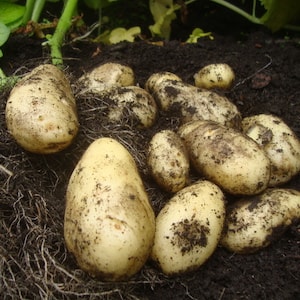
Image: Potato ‘Sharpes Express’
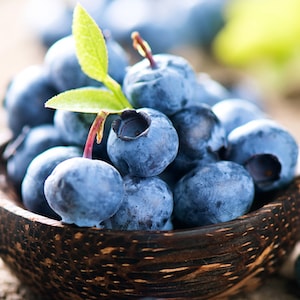
Image: Blueberry ‘Duke’
Allotment fruit in August
- Cover your fruit bushes with netting as they ripen, or you may find the pigeons get there first! Raspberries are generally okay but strawberries, currants and blueberries will be guzzled if left unprotected.
- Strawberry plants are sending out runners now and it’s easy to peg down the strongest one (often nearest to the parent plant) into a pot to create a new plant. Once it roots in the pot, detach and plant it elsewhere. Don’t use diseased or weak plants – it’s far better to buy new ones.
- Tidy your strawberry bed. Replace any plants that are more than three years old with fresh ones, and remove dead leaves to improve airflow around them.
- When your summer-fruiting loganberries and raspberries finish, cut the fruited canes back to ground level.
- Blackberry picking season will soon be upon us. The variety ‘Loch Ness’ has thornless stems making it suitable for plots where children visit. It’s also a very heavy cropper. If you have limited space then the thornless, dwarf variety, blackberry ‘Opal’ is ideal.
- Give your trained apple and pear trees a summer prune. Cut this season’s new growth back by a third to expose the developing fruit to the light.
- Some light pruning of fruit trees can take place in late summer. Apples that fruit on spurs can be lightly pruned to encourage the formation of spurs on newer wood. Summer’s the only time you can safely prune plum trees to avoid the risk of silver leaf disease.
Crops to harvest in August
- Some of the many crops in season include blueberries, cabbage, calabrese, cauliflower, carrots, French beans, lettuce, peas, radish, spring onions, artichokes, spinach and chard.
- Second early potatoes are ready now. Meanwhile any early maincrop potatoes that need removing due to the risk of blight or slugs can also be dug up.
- The remainder of any overwintered onion sets from last autumn can be harvested now. ‘Stuttgarter’ and ‘Sturon’ are two reliable varieties that I’ve grown for many years.
- Late-summer is when tomatoes really come into their own. If you have a glut, make up batches of passata to freeze and enjoy over winter.
- Your courgettes should be cropping furiously. If you have too many to eat fresh, try turning them into a chutney with other surplus produce, canning them or making and freezing soup.
- Pick runner beans every day. If you find any tough pods missed in earlier summer harvests, add them to the compost heap.
- For the best flavour and texture, harvest your beetroot when they’re just a little bigger than a golf ball. Larger beets can become woody in the centre.
- Sweetcorn should be ready this month. Peel back the leafy outer layer from one cob to check the kernels are nicely plump before picking.
- Garlic can be dug up and left to dry in the sun for several weeks before storing.
General August allotment jobs
- Keep hoeing and weeding your allotment regularly as warm weather conditions continue through August.
- Keep your greenhouse as cool as possible and leave the vents open at night if required. If you’re growing cucumbers, maintaining a decent humidity is important. Wetting the path inside the greenhouse can help with this.
- Water your allotment often, avoiding the hottest part of the day to reduce evaporation and leaf scorch. Focus on newly-planted crops to help them get established.
- Keep an eye out for pests, as infestations can quickly get out of hand. Check your brassicas carefully for cabbage white caterpillars, removing any that you find. Look out for tell-tale clusters of green eggs that signal an imminent hatching.
- If you’re going on holiday, ask one of your neighbours to keep an eye on the plot and offer to return the favour. It pays to make friends with other plot holders.
- Leave an area of your plot ‘messy’ to attract insects to pollinate and protect your crops against pests.
- Watch out for slugs and snails in wet weather conditions. Copper tape can be an effective deterrent to keep them away from pots and containers. Try using wool slug pellets around your ground crops to keep them safe.
- Sow green manure seeds this month for improving any spare ground over autumn.
Planning ahead
- Order autumn-planting garlic bulbs, and onion and shallot sets this month to plant at the end of summer. Split a multipack with an allotment neighbour to save money and avoid surplus.
- Order broccoli ‘Stromboli’ seeds for sowing directly into a prepared seedbed next month. These broccoli plantlets provide an early crop of florets come spring.
- Order spring-flowering bulbs now for a colourful display next year.
Suttons Seeds recommend these areas which may also be of interest.
- Previous month: What to do in your allotment in July
- Next month: What to do in your allotment in September


